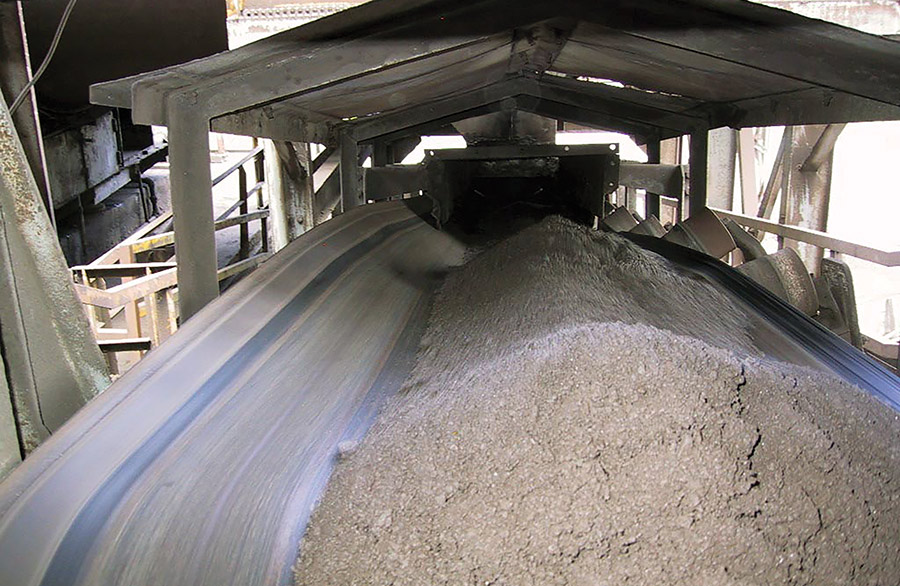A misaligned belt can also come into contact with the stringer, causing fraying, shredding or splice damage. If this condition is not noticed right away, great lengths of valuable belting can be destroyed, and the structural steel itself can be damaged. In fact, a high-speed belt edge rubbing on the support structure can cut through steel mounts with surprising speed, leaving a razor-sharp edge that poses a safety risk.
Further, a compromised bracket or support can cause a catastrophic idler failure, which could damage other components of the system. All of these consequences of mistracking result in added expenses, higher maintenance and reduced efficiency.
Dave Mueller, senior product specialist at Martin Engineering, points out that beyond the many causes for mistracking, the belt training system that came with the conveyor may in some cases actually worsen the problem.
“We are seeing increased belt speeds and greater cargo loads across most industries,” explains Mueller. “But some systems are equipped with belt tracking devices that are not able to handle those higher thresholds. We often see OEM trainers tied off with rope or chain in an attempt to drive a belt back into line.”
In the vast majority of cases, mistracking is a problem that can be corrected. Belt behaviour is based on a set of principles, which serve as the guidelines for ‘belt training’. Training a belt is the process of adjusting the conveyor structure, rolling components and load conditions to correctly centre the belt. Wandering is prevented by first understanding the basic patterns of belt behaviour and then following established procedures to carefully align the structure and components to correct any fluctuations in the belt’s path.
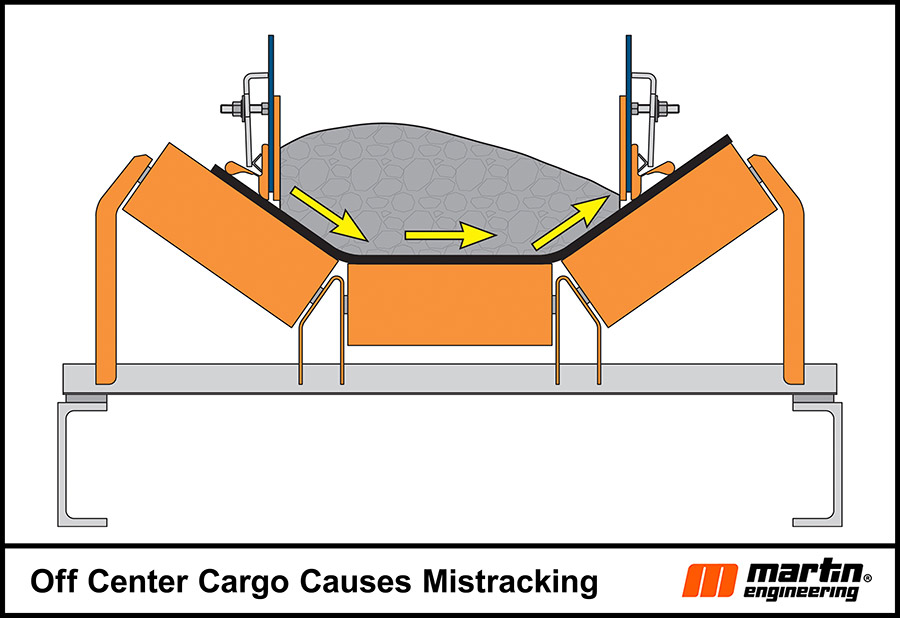
Mistracking indicators
Belt drift can begin in any part of the conveyor system, and identifying mistracking is the first step toward correction. All of the traits listed below could be indicators of mistracking.
Edge Fraying – Probably an indication that the belt is rubbing on the conveyor frame at some point, degrading the edge, reducing the usable width and increasing the chance of a fire.
Excessive spillage – Could mean that one side of the belt has drifted higher on the trough angle, allowing cargo to discharge along the belt path.
Idler fouling – An off-centre load and uneven belt plane can foul idlers. Bearing abrasion can then cause the idler to seize, and the ensuing friction against the running belt can erode its coating and increase the risk of fire.
Off-centre at head or tail pulley – This type of drift can lead to a fast-moving belt coming into contact with the conveyor stringer structure. There is also a chance of splice failure, which puts the entire system in jeopardy of the fast-moving belt detaching and causing a serious injury to workers in close proximity.
Lack of tail pulley protection – On many systems, the belt collects lumps of spilled material on the non-carrying side. If these objects are not removed, they can become trapped between the tail pulley and the belt, causing mistracking and often doing significant damage to both.
Uneven discharge – As the belt drifts to either side of the head pulley, the belt cleaners do not properly clean the entire surface, causing excessive carryback. Material collects on the pulleys and structure, fouling the return side of the belt, resulting in slippage, lost product and other negative effects.
Uneven loading – If the belt path leading from the tail pulley into the loading zone is uneven, the cargo can be loaded off-centre and cause excessive spillage. This may also be caused by inadequate transfer point design.
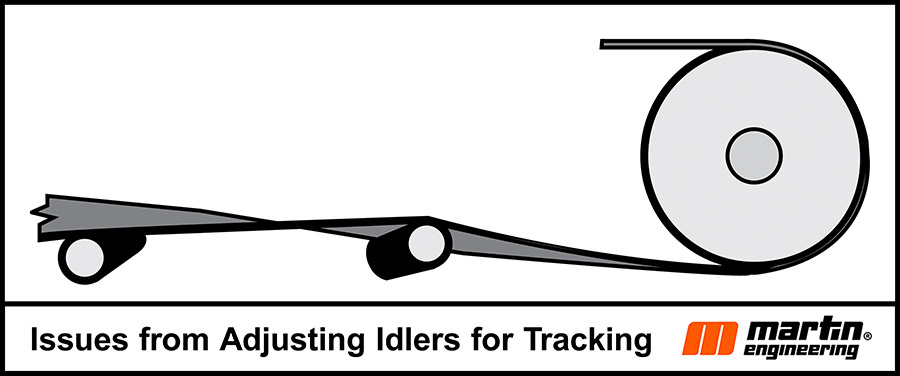
Identification begins at the head pulley
Starting at the head pulley, the belt should also be inspected for cupping, bow/camber (a long curvature) or crooked splicing. When observing the empty belt running over the head pulley, a cambered belt will drift to one side in the middle of the camber and then slowly return to centre as the belt travels through the head pulley. If a splice is crooked, the belt’s path will jump quickly to one side as the splice travels across the pulley.
If it is discovered that these factors are the cause of mistracking, adjusting the conveyor’s rolling components will not correct the issue. The only options are either replacing the belt, or – in the case of crooked splice(s) – re-splicing the belt, assuming there is enough extra belting in the take-up system to allow removal of the faulty splice section.
During the observation procedure, if the belt moves to one side and stays there, the problem may be one of three things: the head pulley lagging is not consistent, the last few carrying idlers prior to the pulley are out of alignment or the head pulley itself is not properly adjusted.
Causes
Mistracking just after the head pulley on the conveyor’s return has two main causes. The first might be that the lagging is missing on one end of the pulley, so the pulley’s diameter is off-centre, placing uneven pressure on the belt and causing it to wander. If this is not the case, then the belt cleaning system may have been mounted slightly askew, putting greater pressure on one side of the belt and pulley. This uneven friction can also lead to mistracking.
Once operators and maintenance professionals properly identify the type of misalignment, they can then seek out the cause. “We have observed that there are three groups of common causes for mistracking,” Mueller points out. “One is a fault with the belt or splice, another group is the conveyor’s structure, components or environment, and the last is due to improper material loading.”
Belt and Splice – If the belt is poorly manufactured or stored improperly, it can bow or camber. Poor installation of a vulcanised or mechanical splice can result in a splice that causes belt tracking problems. Exposure to the elements or to chemicals can degrade the carcass (plies or cords) and the cover of the belt. Faults and damage caused by mismatching the belt to the application and/or operating environment can require frequent replacement.
Conveyor Structure – Inaccurate alignment of the conveyor stringer structure can have subtle but lasting effects on the belt’s performance. Structural misalignment can happen due to age, bumps caused by machinery, effects of seismic activity, or even ground settling.
Outdoor conveyors – High winds require ‘wind loops’ to keep the belt in line. Exposure to extreme temperatures on one side of the conveyor can make components expand, causing changes in friction.
Improper Loading – The load’s centre of gravity will seek the lowest point of the troughing idlers, so if the belt is not centre-loaded, the weight of the cargo pushes the belt toward the conveyor’s more lightly-loaded side. This can be corrected by installing a central loading transfer chute or by using deflectors, grids or chute bottoms that can be adjusted to correct the placement of the load on the belt.
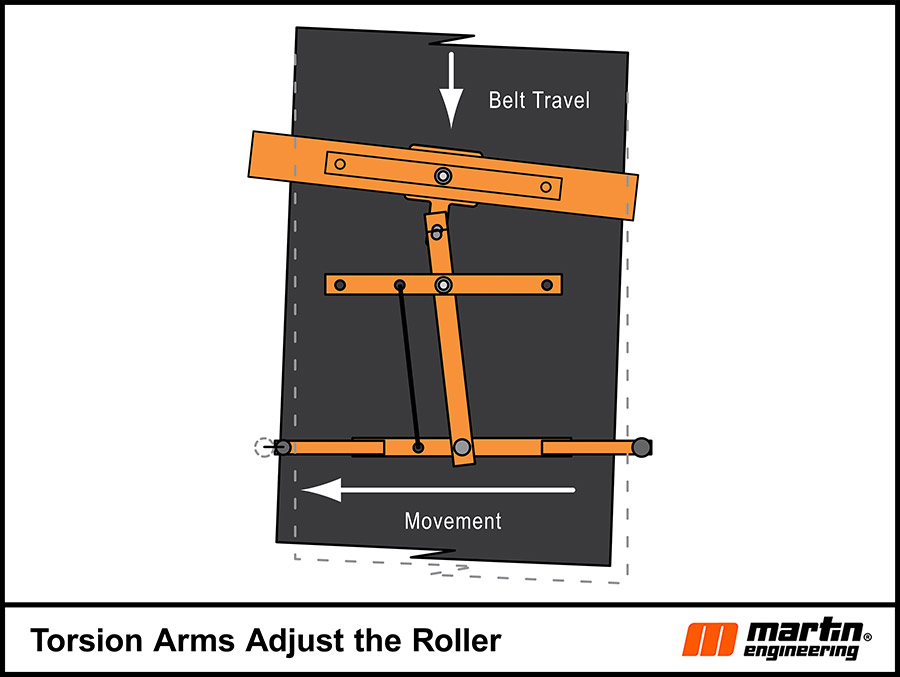
Belt training
A common procedure to correct the wandering belt is to slightly adjust the return and carrying idlers against the direction of the mistracking. Unfortunately, the approach does not work on reversing belts. An even more serious consequence is that over time a number of the idlers may be misaligned, ‘fighting’ each other, as it were, to correct the alignment.
When idler training is not successful as a long-term solution, operators may be faced with a situation where the training procedure is repeated on a frequent (sometimes daily) basis. At that point, managers should consider installing some form of engineered training solution to mitigate the problem.
Engineered training solutions are devices that sense the position of a belt and, through a mechanism or geometry change, actively adjust its path. Some of the most common types include:
Belt Misalignment Switches – The wandering belt pushes a lever arm and activates a switch, which either sets off an alarm or stops the system. Costly downtime can result from these systems.
Vertical Edge Guides – These are positioned perpendicular to the belt’s path to keep the edge away from the conveyor structure and should not be used to compensate for persistent misalignment problems. Use of these guides is most practical on short, low-tension systems and is not particularly effective on thin belts, as operators have experienced the belt rolling over on itself.
Vee Idlers and Rollers – Set on both the cargo side and return side of the belt, these use a trough configuration and edge brackets that rely on a centering force to correct the belt path, which can add stress on the belt and lead to damage. These systems are more expensive and require more maintenance than a conventional return idler.
Crowned Pulleys – The raised portion of the pulley (the crown) touches the belt first and the outer sections of the belt on both sides produce a force driving it toward the centre.
Dynamic Belt-Tracking Systems – These use the force of the mistracking belt on an arm that moves an idler, creating a steering action that directs the belt back into the centre.
In-Line Sensing Roll Trainers – These have vertical guide rolls that are mounted on both sides of the belt, in line with the roller, with the centreline running through the idler’s pivot point. Movement of the belt against either guide roll causes the roll to move in the direction of the misalignment, pivoting the entire idler.
Leading Sensing-Roll Trainers – Employing either a pivoting carrying roll or troughing set, short arms on both sides of the frame are positioned in advance of the pivoting roller and end in guide rolls located 25 to 75 mm from the belt edge.
Torsion-Spring Trainers – These improve upon the leading sensing-roll trainer design by removing one sensing roll and incorporating a spring into the pivot, which keeps the one remaining sensing roll in constant contact with the belt edge.
Multi-Pivot Belt Trainers – These use longer arms than other designs, positioning the guide rolls further from the pivot roller, as well as closer to the belt edge. The closer proximity allows guide rolls to sense very slight misalignments and make immediate corrections. Rather than waiting for a powerful mistracking force, the longer arms require considerably less force to move the pivot roller. The result is better correction with no pinch points and less wear on conveyor and tracking equipment, for a longer and more efficient service life.
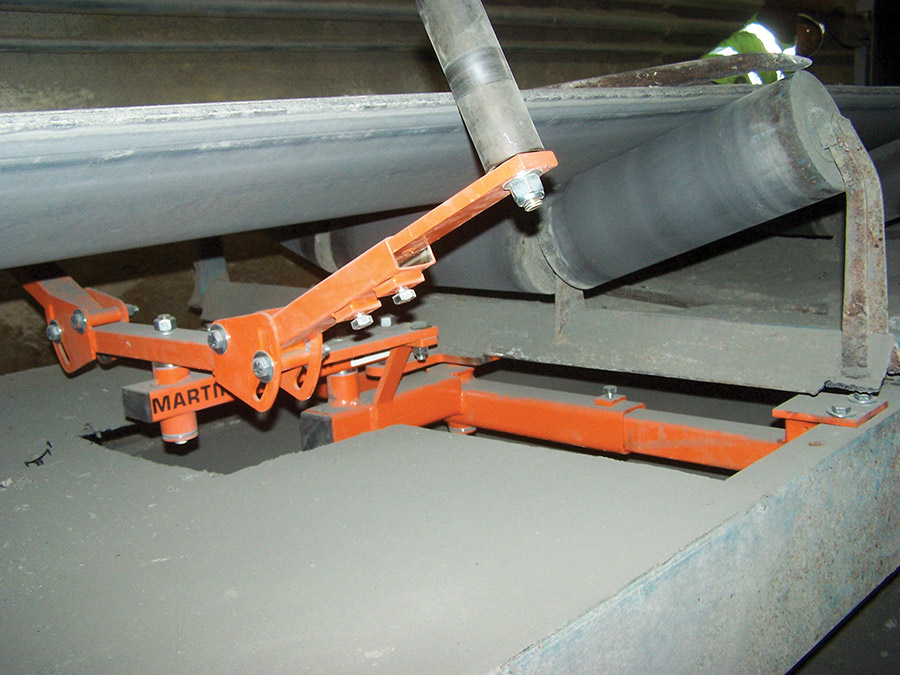
Total conveyor analysis
“Installing trackers is the economical solution, but operators should do a full analysis and consider also addressing other causal issues,” Mueller adds. “By focusing solely on belt alignment, plant personnel may miss other opportunities to increase production and relieve some of the burden on their system.”
Off-centred loading is a major cause of mistracking. To remedy these issues, some conveyor accessory manufacturers offer well-engineered modern equipment such as load-centering transfer chutes, high-impact cradles, adjustable slider cradles, an assortment of cleaner blades created for specific applications and redesigned chute box technology.
Keeping the belt centred and moving quickly is the key to high production, a low cost of operation and a safer workplace. “Misalignment causes downtime and costs money,” Mueller concludes. “But nothing causes more downtime and expense than a destructive belt fire or other catastrophe as a result of inattention to mistracking problems.”
